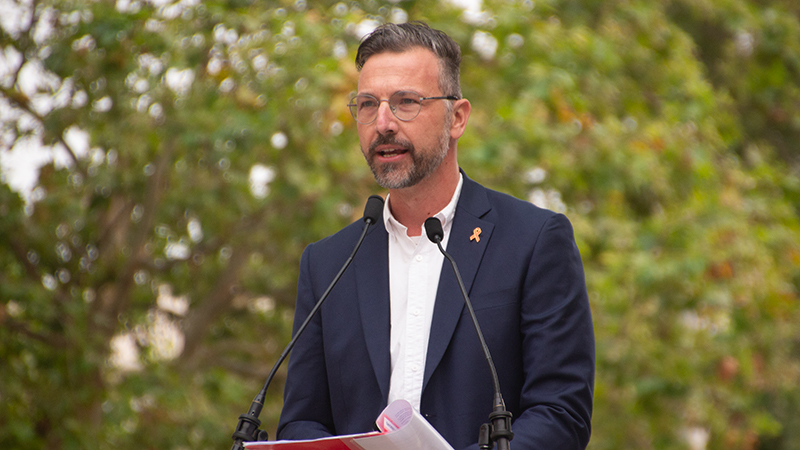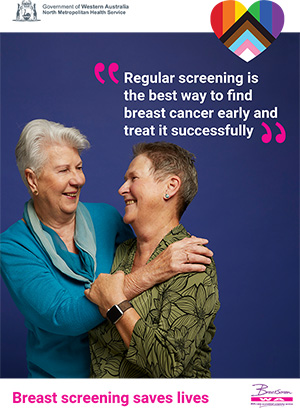Australia has set the goal of virtual elimination of new transmissions of HIV by 2030, we sat down with Dr Daniel Vujcich, CEO of WAAC to get a better understanding of what that entails.
This is the second story in OUTinPerth’s The Last Mile project which is exploring strategies on how Australia can reach it’s 2030 goals for HIV.
Opt-out testing in hospitals, self testing vending machines, and more discussions prompted by GPs are some of the ideas to make an impact.

Asked how he’d describe the concept of virtual elimination of HIV to someone who had not previously come across the concept, Dr Vujcich offers the following explanation.
“The way they’ve calculated the target for virtual elimination, it’s a 90% reduction in new cases diagnosed in Australia compared to what the baseline level was at 2010 when those targets were set.
“So in 2010 nationally, we had 895 new cases of HIV diagnosed in Australia. So a 90% reduction of that by 2030 would mean no more than 90 cases nationally by 2030.”
Dr Vujcich describes the target as ambitious, and at this stage it looks unlikely that Australia will reach the goal.
“I would say it is ambitious, and we’re unlikely to reach it unless there is a fundamental systemic change.” he said.
“If we are aiming for no more than 90 cases nationally by 2030, we are a long way from that, in that last year we had over 700 cases nationally.
“If we’re looking at sort of 90% of the rates of the numbers of HIV notifications in WA from 2010, well, in 2010 we had about 101 cases I think, so the target for 2030 would be no more than 10 cases.
“Last year in WA we had over 70 cases of HIV. And so it seems unlikely that, with all things being equal, we’re going to see a radical shift in those numbers in order to reach the 2030 goals.”

Who do we need to focus on?
When the WAAC CEO spoke about the issue at World AIDS Day in 2024 he noted that there were six groups of people who would most likely still be facing challenges relating to HIV as we head towards to goal of virtual elimination. And while in the past education campaigns targeted larger cohorts, as we move forward, the messaging and approaches most likely need to be specifically tailored to each group.
“I think they are going to be different approaches and that’s kind of why this, for want of a better word, ‘tail end’ of the epidemic is kind of the most stubborn.” Dr Vujcich said.
“It would be simplistic to say that it has been easy to get where we are in relation to gay and bisexual men, because actually a lot of work went into that over many decades in order to achieve that. But we are at the stage now where gay and bisexual men are really knowledgeable about HIV.”
Dr Vujcich highighted the great uptake of preventative treatments like PrEP, which has changed the landscape of HIV prevention, as a major change in recent years, and he notes that gay and bisexual men have connected communities and a high level of health literacy.
“What we’re seeing in terms of the communities that are being left behind is that they’re really diverse.” Dr Vujcich noted.
He cites people who are born overseas as one target group, highlighting that although people may come from countries with a higher prevalence of HIV they may not think of Australia as place where HIV is something they need to continue to think about.
“We’re seeing overseas born people, people who might be coming to Australia and have this perception that HIV isn’t an issue over here, because they see Australian as ‘a safe kind of country’ with low prevalence of HIV, and therefore they might have a really low perception and might not necessarily engage in the same protective behaviors that they might have engaged with in their country of origin.” Dr Vujcich said.
Women are another group of people the WAAC CEO expresses concern about, as well as the number of people who are classed as late diagnosis, people who have been unaware they’ve been living with the disease for considerable time.

The Indigenous communities and street present people are another two groups Dr Vujcich notes will be harder to reach.
“It’s when people have competing priorities, and they don’t have access to housing, and they don’t have access to basic food. Well, then actually trying to get a message about HIV prevention to them might be really low down on their list of priorities.
“That requires a more structural, broader advocacy kind of interventions. The approach for all of those groups is different, which is why this last part of the journey to virtual elimination is the hardest.” he shares.
Dr Vujcich says the campaigns and approaches of the past have been successful in reaching many people who are classed as men who have sex with men (MSM), but a more nuanced approach is needed moving forward.
“We can’t rely on the same old ways of delivering healthcare access to people and just assume that that is going to keep working because it’s worked for the majority. We need to be sort of meeting people where they’re at, and recognizing the many kind of structural barriers and determinants that actually stop people from walking in the door of a health service.” he said.
Advances in medicine are making an impact, but new ways of working are needed too
Advances in medicine are making big impacts and Dr Vujcich says new approaches will be rolled out where they will have the most effect. While PrEP treatment requires people to adhere to a daily medication regime, an injectable approach may soon be rolled out people at most risk who struggle to adhere to that requirement.
Perth has also become a global leader for injectable treatments for those living with HIV, coming only second to San Francisco in uptake of the treatment. The positive effect of this is people who have contracted the virus have an undetectable viral load, meaning they are unable to transmit the virus to other people.
A big change Dr Vujcich would like to see is HIV testing being offered more regularly at primary health settings. If all GPs had routine discussions with their patients it could make a major impact, especially given that many cases in WA are revealed to people who have had the virus for considerable time before being diagnosed.
Installing vending machines that allow for self testing in university campuses is also about to be rolled out.
“The idea is it’s a point of care finger prick test where people don’t have to go to the doctor. They can access it discreetly and without any sense of stigma, and make sure that they they know their status, and there is no cost associated with that. We look forward to seeing that rolled out during the course of this year.” Dr Vujcich said.
Opt-out testing in emergency rooms as worked in the UK
In the United Kingdom they made great advances by implementing a systematic change.
“They’ve achieved really great outcomes as a result of making HIV testing an opt out test whenever someone goes to an emergency room and gets tested for anything. It’s been phenomenal in terms of capturing people who would not have been tested and have not been tested for many years, and are presenting with late and advanced stage diagnoses.
Dr Vujcich cites the UK experiment as the kind of bold move he’d like to see trialed in Australia, and he hopes a national conversation about the proposal will be embraced.
“There’s a question about making sure that the hospitals that you choose have sufficient HIV prevalence for it to be a cost effective option. There are definitely hospitals in Australia where that is the case.” he notes.
He also suggests looking to the success stories in countries like Belgium who have developed an effective program for reaching new immigrants, and also suggests looking to the developing countries who are making inroads even though they have limited resources.
“We always need to recognise the incredible work that’s being done in developing countries, including in Sub-Saharan Africa, where prevalence is huge. We shouldn’t be seeing that as a sign of failure.
“We need to be looking at what those countries are doing really well, in really resource limited circumstances, in order to reach people who have a range of structural barriers that prevent them from accessing healthcare, and look at how we can adopt those models to reach the communities that are being left behind in Australia.” Dr Vucich said.
No room for complacency
One of the greatest danger to reaching the 2030 goals however is complacency. The health expert warns of the dangers of an attitude of ‘near enough is good enough’ which may arise as the levels of new cases of HIV begin to drop. Dr Vujich says sustained effort is essential.
“As soon as you take your foot off the accelerator, you’re going to start seeing a rebound in rates, and we’re going to go back to where we were. That is the risk.” he said.
He also expresses concern about recent cuts to HIV prevention efforts on as global level. This year US President Donald Trump pulled funding from many international programs, and Dr Vujcich warns that while the effects will hit developing nations first, the results will flow through to countries like Australia.
Finally he shares his concern over the 90 people annually who will still be diagnosed with HIV even if Australia does reach it’s 2030 goals.
“If we do reach 90 cases nationally, looking at who those 90 cases are, and recognising that we can’t create a two tier caste system in terms of people that we are okay with getting HIV and people who we don’t want to get HIV.
“We want to send the message that actually any case of HIV in Australia represents a failure in the public health system, not an individual failure, but a failure in the systemic response.”
The Last Mile
The phrase ‘The Last Mile’ grew out of the telecommunications industry where they discovered connecting individual properties to networks was the most challenging task.
In the journey of HIV, Australia is looking down The Last Mile. Which why we adopted the phrase for this new series of reports that explores how the goals of 2030 can be achieved.
This is a Solutions Based Journalism project. The goal is to interrogate the challenge, explore the data, hear the stories and experiences and present the ideas and practices that will hopefully lead us to all achieving the 2030 goals.
Contact
Graeme Watson
Co-editor
graeme@outinperth.com
Related Posts





